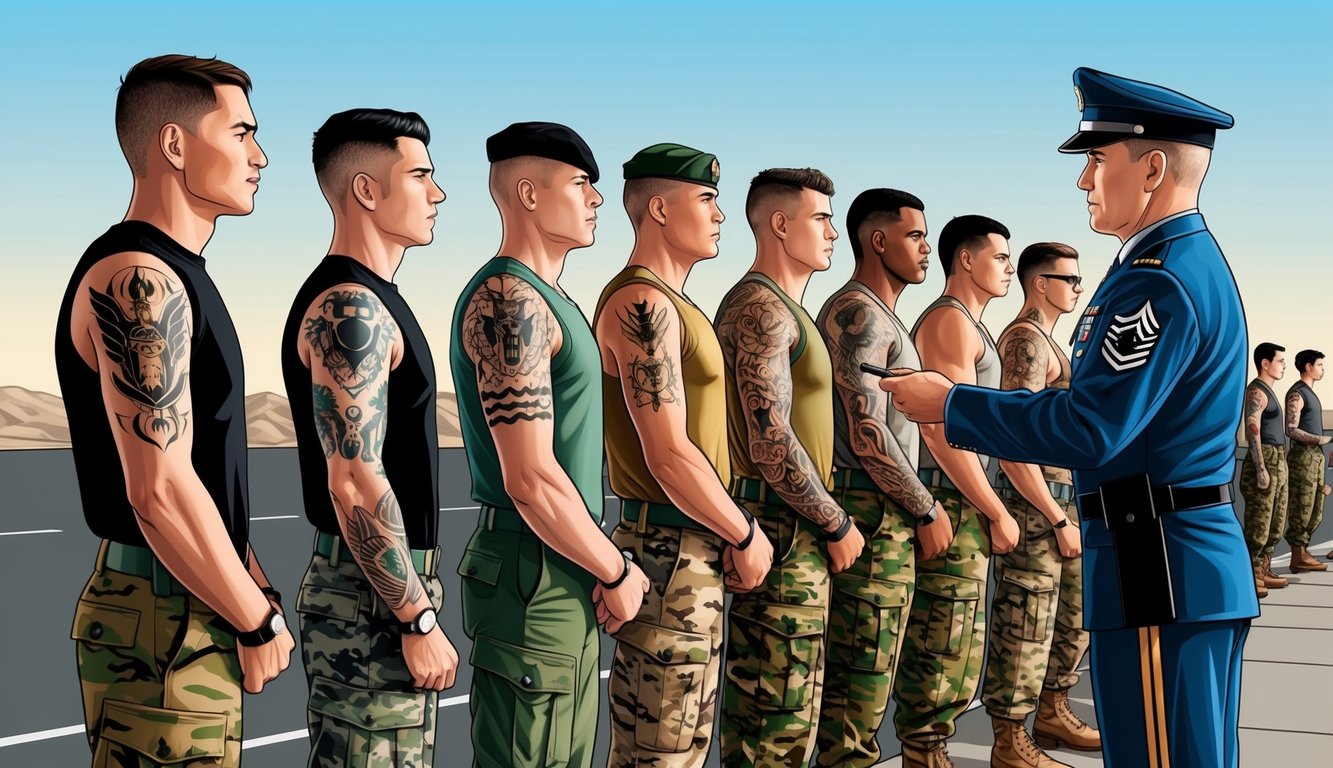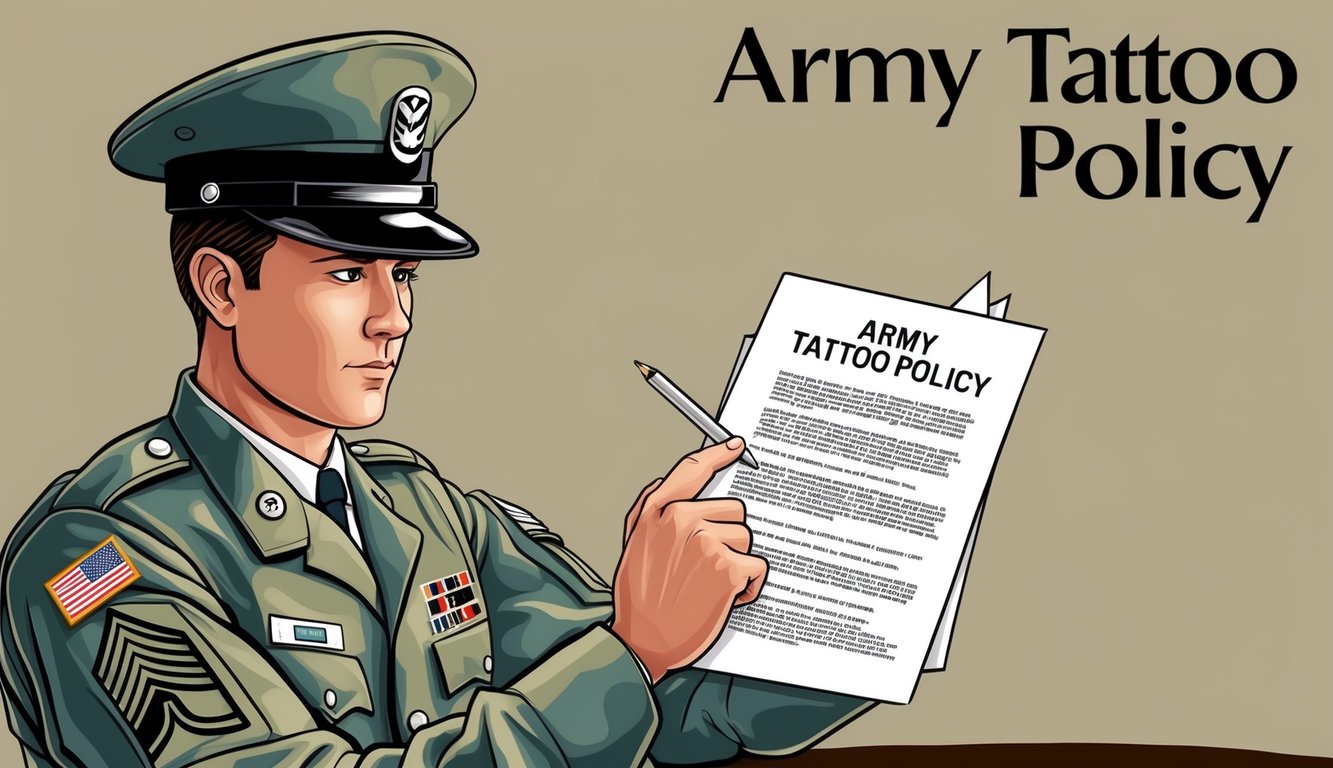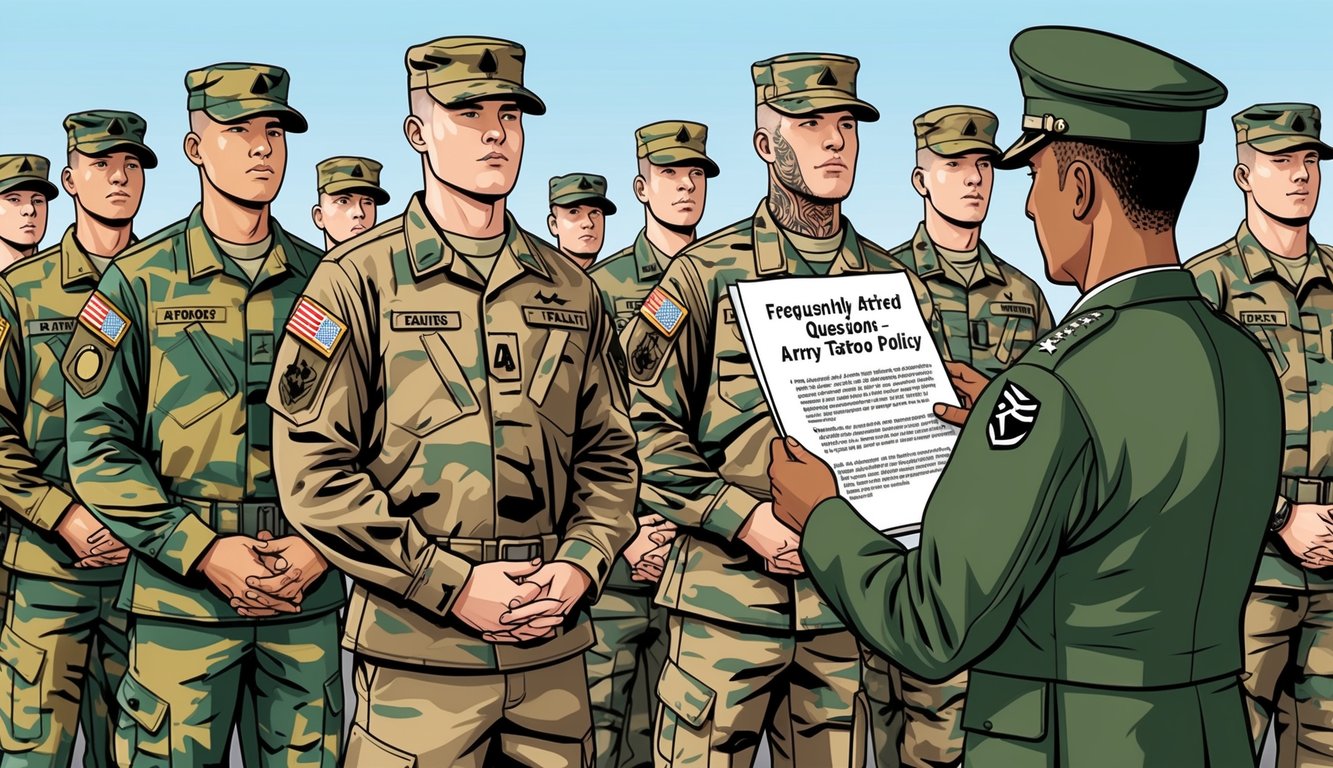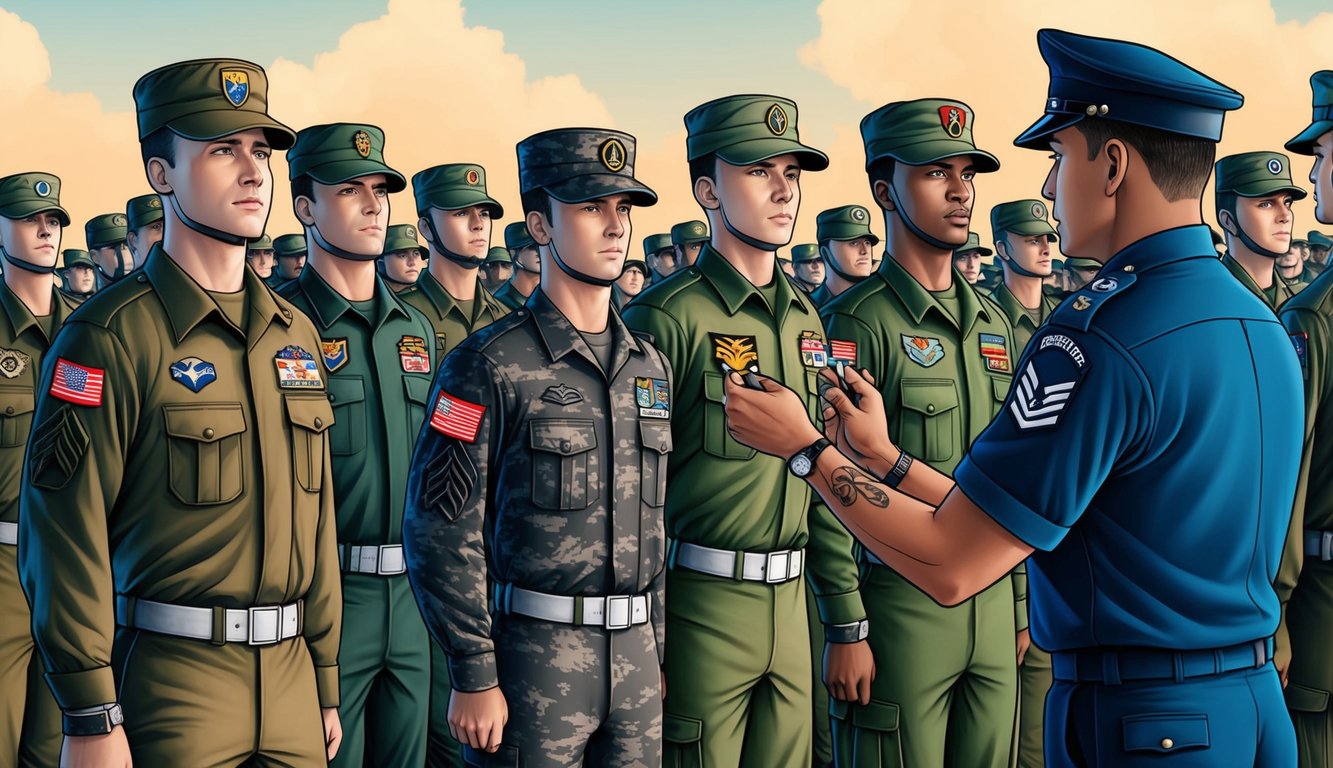The Army’s tattoo policy has seen considerable evolution in recent years, aligning with changing societal values and recruitment objectives. Starting in 2024, the U.S. Army will permit tattoos on the hands, necks, and behind the ears, subject to specific size and content limitations. This amendment signifies a shift away from the previously more restrictive stance on visible body art.
You may find it surprising that the Army has lifted restrictions on tattoos in certain areas that were once prohibited.
This change is intended to broaden the pool of qualified candidates and recognizes the increasing acceptance of tattoos among newer generations.
The updated policy strives to merge individual expression with the need for a professional appearance.
Despite the Army’s relaxed approach, important guidelines remain.
Tattoos on the face and head are still not allowed, and there are limitations regarding the size and number of tattoos permitted in certain locations.
Additionally, the Army continues to prohibit tattoos that feature offensive or extremist imagery.
Key Takeaways
- The Army now permits tattoos on hands, necks, and behind ears with certain restrictions
- Facial and head tattoos remain banned, and offensive content is prohibited
- The revised policy is designed to enhance recruitment while upholding professional standards
History of the Army Tattoo Policy
The Army’s tattoo policy has evolved significantly over the decades, reflecting shifts in cultural attitudes and military requirements.
Historically strict regulations have transitioned to more lenient guidelines, impacting recruitment and retention strategies.
Evolution Over Time
Previously, the Army enforced rigid tattoo restrictions, prohibiting visible tattoos while in uniform and limiting placement to areas that could be easily concealed.
As cultural perceptions evolved, so too did the policy.
A significant change occurred in 2015 with the update of AR 670-1, which lifted the limitations on the number of tattoos permissible on arms and legs, acknowledging tattoos as part of mainstream culture and aiding recruitment efforts.
Previous Restrictions
Prior to recent modifications, strict regulations governed tattoo size, content, and location.
Tattoos above the neckline or on the hands were forbidden, and offensive or extremist images were banned.
Size limits restricted arm tattoos to a maximum size of one’s hand.
These stringent rules often resulted in disqualifying qualified candidates or imposing limitations on the careers of existing soldiers.
The rigidity of the policy frequently conflicted with operational needs and cultural changes, necessitating ongoing updates to reconcile tradition with contemporary realities.
Current Army Tattoo Regulations
The U.S. Army’s updated tattoo policy aims to provide greater flexibility for soldiers while maintaining professional standards.
While there are now more options for tattoo placement, certain restrictions concerning content and visibility remain in place.
Allowed Tattoo Locations
Soldiers are now allowed to get tattoos in previously restricted regions.
Tattoos on the hands are now permitted, along with one allowed tattoo on the back of the neck, as long as it does not extend beyond the hairline.
Tattoos behind the ear are also acceptable.
These changes grant increased freedom for self-expression while in uniform.
However, facial tattoos remain banned.
The Army continues to impose some limits on highly visible body art to uphold a professional military appearance.
Prohibited Tattoo Content
Even though the Army has eased location restrictions, content guidelines remain stringent.
Tattoos that are extremist, offensive, racist, sexist, or contain hateful language are prohibited.
The Army promotes unity and respect among its personnel.
Tattoos that may be deemed discriminatory or detrimental to good order and discipline are not allowed.
This includes symbols affiliated with hate groups or extremist organizations.
All tattoo content should align with the Army’s values and ethics.
Size and Quantity Limitations
The Army has eliminated many previous restrictions concerning tattoo size and quantity on arms and legs.
Soldiers are no longer confined to a specific number of tattoos in these areas, allowing for more elaborate body art on their limbs.
Nevertheless, some limitations still apply.
Neck tattoos must be smaller than 2 inches in diameter, and hand tattoos should consist of only one ring-style tattoo per hand.
These guidelines aim to balance personal expression while ensuring a professional military demeanor.
It’s crucial to consult the most recent AR 670-1 regulations prior to getting a new tattoo, as policy updates may ensue, and remaining informed is essential for compliance with Army standards.
Exceptions and Waiver Process
The Army’s tattoo policy allows for specific exceptions and waivers in unique circumstances.
These provisions are designed to accommodate recruits and service members with existing tattoos or specific needs.
Medical and Religious Waivers
If you find yourself in a situation that falls outside the standard tattoo policy, you may qualify for a medical or religious waiver.
Medical waivers could be relevant for tattoos intended to conceal scars or medical conditions.
For religious reasons, you might obtain a waiver for tattoos that are integral to your faith practices.
Army Directive 2022-09 outlines the procedure for requesting these waivers.
You will need to provide documentation supporting your claim.
Medical waivers generally require a doctor’s note, while religious waivers may necessitate a letter from your spiritual leader.
Utilizing bandages or coverings to conceal non-compliant tattoos is not a long-term solution.
The Army expects either removal of the tattoo or acquisition of a proper waiver.
Waiver Exceptions for Recruits
For recruits with tattoos that do not comply with current standards, there is still hope.
The Army provides waiver exceptions to keep military options open for more potential soldiers.
Detailed information about your tattoos will need to be submitted during the enlistment process, including photos, descriptions, and locations.
A review board will assess your case.
Waiver exceptions are more likely for tattoos that aren’t deemed offensive or extremist.
Hand tattoos, for instance, may be approved if they are small and non-intrusive.
Each case is considered individually, weighing your potential contributions against policy requirements.
Implications for Recruitment and Career
The Army’s tattoo policy has a substantial impact on recruitment and career advancement.
Recent changes have opened doors for tattooed individuals to enlist and progress within the military.
Impact on Enlistment Process
For those with tattoos, the enlistment process is now more accessible.
The Army’s relaxed restrictions now permit visible tattoos on hands, necks, and ears.
This modification aims to expand the pool of potential recruits during challenging recruiting periods.
When applying, recruiters will still evaluate your tattoos, but with greater flexibility.
Offensive or inappropriate designs are still not allowed, so make thoughtful choices regarding your ink.
These policy changes demonstrate the Army’s acknowledgment of shifting societal attitudes and the necessity to attract skilled individuals.
Tattoos and Professional Military Development
Visible tattoos will not hinder your advancement in your military career as much as before.
The Army has recognized that body art does not necessarily compromise professionalism or job performance.
You can advance through ranks with tattoos that were previously disqualifying, except for facial tattoos, which remain prohibited.
As you progress, maintaining a professional image will be essential; your conduct and performance will predominantly determine career advancement rather than your tattoos.
The Army aims to balance personal expression with the maintenance of discipline and order.
Comparison with Other Military Branches

While the Army’s tattoo policies have become more lenient, other military branches maintain their own distinct regulations.
These varying rules can impact service members contemplating transfers.
Let’s explore how the Air Force and Space Force policies compare and their potential implications for interbranch transitions.
Air Force and Space Force Policies
Both the Air Force and Space Force enforce tattoo policies that are somewhat stricter than those of the Army.
Hand tattoos are generally allowed only as a single ring tattoo per hand.
Additionally, face and neck tattoos are prohibited, aside from small tattoos behind the ear.
There are also different size restrictions.
Tattoos must not cover more than 25% of the visible body part when in uniform.
This requirement may necessitate cautious decision-making regarding larger or more numerous tattoos on the arms and legs.
Unlike the Army, neither the Air Force nor Space Force permits tattoos on the head or scalp, and they also enforce more rigorous rules regarding tattoo content, barring designs that could be interpreted as offensive or extremist.
Impact on Interbranch Transfers
If you’re thinking about transferring from the Army to another branch, your tattoos could present a challenge.
The Army’s more relaxed policies may leave you with tattoos that conflict with the regulations of your new service.
For example, hand tattoos that do not conform to the Air Force’s single ring policy may bar you from transferring.
Similarly, neck tattoos that are permissible in the Army might inhibit your enlistment in the Navy or Marines.
Before applying for a transfer, it’s vital to thoroughly review the tattoo policies of your intended branch.
In some instances, you may need to have tattoos removed or modified to conform to the new regulations.
This process can be both time-consuming and costly.
Guidance for Soldiers with Tattoos
The Army’s tattoo policy aims to strike a balance between individual expression and military professionalism.
Soldiers must be aware of and adhere to specific guidelines to ensure their tattoos comply with regulations.
Maintaining Army Standards
When it comes to tattoos, compliance with Army Regulation 670-1 is essential.
Visible tattoos are now allowed on hands, behind the ears, and on the back of the neck, but there are size restrictions.
Hand tattoos must not exceed one inch in any direction, while neck tattoos should remain below the hairline and should not be visible while in uniform.
Facial tattoos are still forbidden, excluding permanent makeup.
Avoid tattoos that are offensive or extremist.
If there is any doubt regarding a tattoo’s appropriateness, it’s advisable to consult your chain of command.
It’s crucial to keep tattoos well-maintained, as faded or unclear ink can appear unprofessional.
Consider touch-ups when necessary but ensure you remain within policy guidelines.
Annual Inspections and Consequences
Annual tattoo inspections will be part of your regular health assessments.
Commanders will review any new tattoos to ensure they comply with Army standards.
Violating the tattoo policy could lead to disciplinary action, which may include counseling, extra duty, or severe cases potentially resulting in separation from service.
Documenting existing tattoos during enlistment or as policies change can protect you from future complications if regulations become stricter.
Remember, waivers might be available for certain tattoos.
If you have concerns about meeting compliance, discuss your options with your leadership.
Future Trends and Societal Attitudes

The Army’s tattoo policy is likely to continue adapting alongside evolving cultural norms.
As tattoos gain broader acceptance, the military is facing pressure to update its regulations while maintaining professionalism and cohesiveness.
Shifting Views on Tattoos
Tattoos are increasingly viewed as socially acceptable throughout society, particularly among younger generations who regard body art as a means of self-expression and individuality.
This transformation is influencing military culture.
The Army understands that outdated tattoo regulations could hinder recruitment efforts.
By allowing greater visibility for tattoos, like those on necks and hands, they are responding accordingly.
Nonetheless, prohibitions against facial and head tattoos (except for permanent makeup) remain in effect.
In response to shifting attitudes, further relaxations in rules may be forthcoming.
There could eventually be allowances for small, tasteful facial tattoos or expanded approval of content beyond what is currently deemed “socially acceptable.”
Adapting to Cultural Changes
The military strives to represent the diverse society it serves.
Expect ongoing policy adjustments as commanders align tradition with contemporary norms.
Future revisions may include:
- Broader acceptance of tattoo styles and imagery
- Relaxation of size and placement restrictions
- A more streamlined waiver process for existing tattoos
Finding balance between maintaining a professional image while embracing individuality will be a challenge.
Potential changes will likely be gradual rather than abrupt.
The Army may introduce more nuanced policies, potentially differentiated by combat versus non-combat roles or varying standards based on rank and visibility.
Resources and Official Documentation

The Army provides several resources for soldiers to understand and comply with tattoo regulations.
These official documents offer detailed outlines of policies and guidance on appropriate uniform wear.
Army Publishing Directorate Resources
The Army Publishing Directorate (APD) serves as the primary source for the most current tattoo policies.
On the APD website, you can access Army Regulation 670-1, which includes appearance standards encompassing tattoos.
Army Directive 2020-09 is also available, offering the latest updates on tattoo regulations.
This site provides PDFs and interactive versions of documents for ease of access, and you can set up email notifications to stay updated on any policy changes as they arise.
Guide to the Wear and Appearance of Army Uniforms and Insignia
This comprehensive guide, known as AR 670-1, serves as an essential reference for all aspects of Army appearance standards.
The section on tattoo policy specifies allowed and prohibited tattoo locations, sizes, and content, along with helpful diagrams showing permissible locations on the body.
Additionally, it provides clear descriptions of the review process for existing tattoos and the procedures for acquiring new ink while serving.
This guide is updated regularly to reflect the latest policy changes, so always check for the most recent version.
Frequently Asked Questions

The Army’s tattoo policy has undergone major changes in recent years, aimed at balancing personal expression with military professionalism.
What are the updated guidelines for tattoos in the Army?
The Army now permits tattoos on the hands, neck, and behind the ears.
Facial tattoos remain prohibited, except for permanent makeup.
Offensive or extremist tattoos are not allowed on any part of the body.
How does the Army’s tattoo policy apply to tattoos on the neck and behind the ear?
Tattoos on the neck and behind the ears are allowed but must adhere to size restrictions and not extend onto the face or head.
The policy aims to provide additional flexibility while preserving a professional image.
What are the size restrictions for hand tattoos in the Army?
Hand tattoos are allowed, but there are limitations.
You may have one ring tattoo per hand, and other tattoos must not exceed one inch in any direction.
Can you still enlist in the Army if you have tattoos that don’t comply with the regulations?
If your tattoos do not align with current standards, you may still have possibilities.
The Army provides waivers in some instances, so it’s important to discuss your specific circumstances with a recruiter.
How has the Army tattoo policy changed going into 2024?
The 2024 policy continues the trend toward relaxed restrictions, allowing greater freedom in tattoo placement and size.
The focus remains on prohibiting offensive or extremist content rather than imposing strict location rules.
Are there any differences in tattoo regulations between Army officers and enlisted personnel?
The tattoo policy is uniformly applicable to both officers and enlisted personnel.
All ranks must adhere to the same standards concerning tattoo placement, size, and content to ensure consistency across the board.

